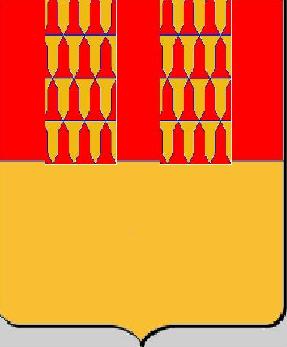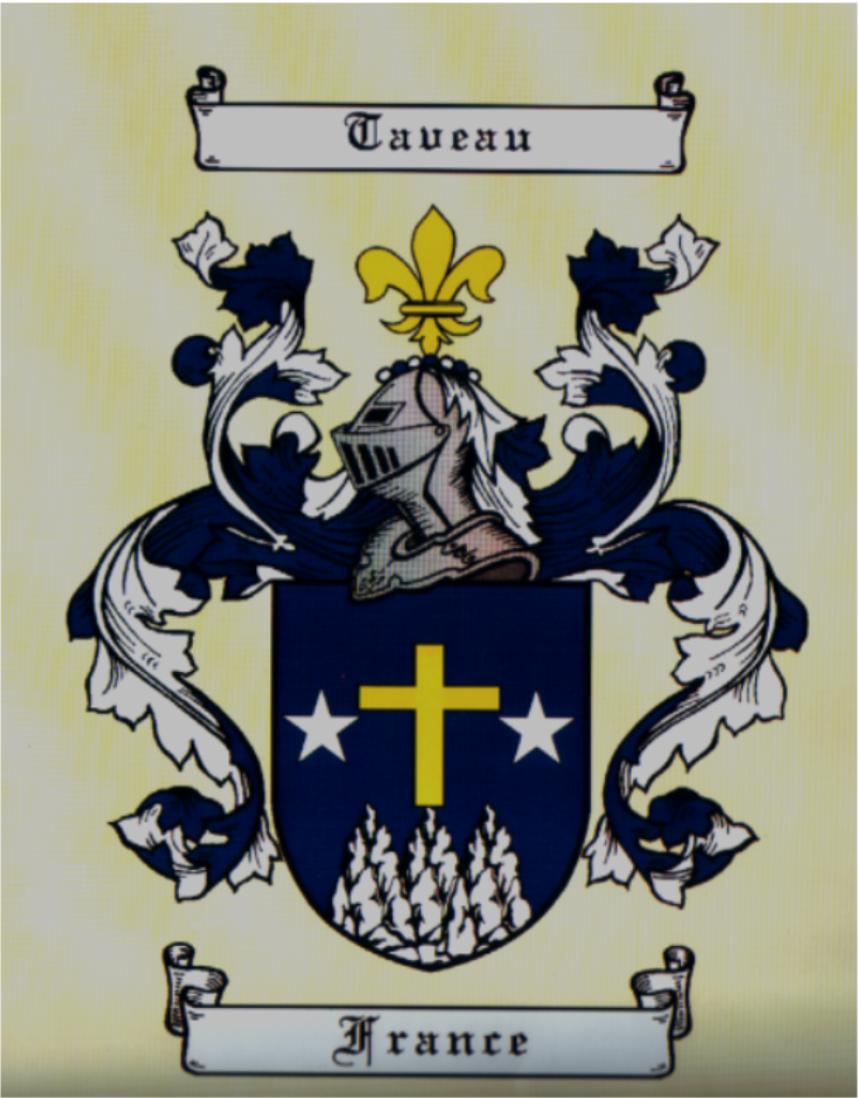

Introduction:
Taveau
is a French family name that originated from Tavel. Tavel is an occupational
name. This type of name was very common during the Middle Ages in Europe.
Tavel came from “tavelle” which was a small piece of textile or ribbon used
by the military. It also meant a small piece of leather to attach the top cover
of chariots.
The first Tavel was probably a manufacturer or a merchant of such fabrics. Tavel is also the name of a village in the Gard area and the first Tavel could have been from this area.
The variants for Tavel are Taveau and Tavard.
1-
Family History
It is confirmed that, at the end of the 14th century, the Taveaus were well established in the triangular area formed by the cities of Poitiers, Angers and Tours in the Loire Valley.
The oldest “official and public” documented archive referring to a Taveau is on a wedding certificate from June 24th, 1508 where Jean Taveau, ecuyer /squire was a bestman.
Also, Jehan Taveau, farmer, was the first of a long line of Taveaus beginning in 1525. It is the most documented branch of the Taveau family to date.
The Taveaus in the Loire Valley seemed to be owners of large portions of land as farmers or landlords resulting from the years of service to the King of France (as squires or knights). At that time, they came to be known as the Taveau de Morthemer (spelled also Mortemar, Mortemard, Mortemer, Mortimer). To date, the addition of Morthemer to the Taveau family is not clear but the most probable explanation, based on different sources (incl. the precious key element provided by Francois Taveau from Poitiers, France) is:
According to the local archives of the Vienne area (Poitiers), the noble branches of the family appeared because of the status as mayors by some individuals. These people were for example later on Guillaume Taveau, mayor of Poitiers in 1370 and Pierre Taveau, mayor of Niort around 1410. Still today, any person bearing the name of Taveau is considered a member o the Barony of Morthemer.
At this time, in the middle of the raging "War of 100 years" between the British (subjects of the King of England, descendant of Alienor from Aquitaine (Bordeaux) and the French (subjects of the King of France from the Dukes of Paris), the only way to preserve the fragile Kingdom of France was by giving nobility to mayors of key cities. Poitiers, strategic crossroad between Aquitaine and England was first on the list. Niort followed. The "noble" family from Guillaume Taveau then lived for more than 5 centuries in the Castle of Morthemer, next to Lussac, in the southern part of the Vienne area. The Taveaus became nobles because of their charges and also because of their locations. Would they have lived in the Eastern part of France and it will have been a different story. we may guess this was the reward for being faithful to their lands.
The Morthemer addition to Taveau’s family name came from the appropriation of the Barony of Morthemer (Mortimer) (1st reference with the Cardinal de Morthemer in 1405). The Morthemer family was from the town of Morthemer in Normandy where many battles between the King of France and the Normans took place. Roger de Mortimer fled Normandy to England and then came back. The King of France, at the time, seized the Barony of Morthemer and, when events settled, relocated it to the Loire Valley and granted it to the Taveaus (probably in the early 1200s). Also with many changes of alliances at this time, a Morthemer may have moved to the side of the King of France and found a place in the Duche du Poitou.
The History of the Castle of Morthemer itself fits this trouble period of History with it changing from side to side between French or English for support. Sir John Chandos, descendant from Guillaume the Conquerant died from his wounds at the Castle of Morthemer after a night skirmish against the French on December 31, 1369 at a time when it was on the British side.
Amazingly, the name Morthemer fit the description of a large part of the lands owned by the Taveaus which were swamps (les Marais Poitevins), it was just the best way to describe their geographical origins. It became known as the reason of the addition of Morthemer by locals even if the real origin was from Normandy. Morte Mer means Dead Sea or Dead Water.
Pictures of the Chateau occupied by the Taveaus are on the website of the city of Valdivienne formerly Morthemer (site in French).
2
– Clues from the Coat of Arms
It
was brought some time ago to my attention that nobility may have been conferred
as a result of the Second Crusade that was heavily financed by the Taveau
family. During this Crusade, it was Knight Johan Taveau who fought valiantly for
the King of France and the Crusaders. It was not indeed because of the Crusades
that the title of Baron of Morthemer was granted, but because of the Campaign
against the Normans. The elevation from Squire to Knight may have actually come
from the Crusades. Confirmation of the conferring of nobility is evident in the
family Coat of Arms whose helm is topped by a Star (in official heraldry it is
actually a “mullet” which is an upside down star signifying the awarding or
conferring of nobility as a result of demonstrated valor in battle). The motto
of the Family is “Suivez l’Etoile” or “Follow the Star”
in English. There is some suggestion that the Star was a reference to the Star
over Jerusalem. However, there are no official documents to support this theory
and, as a consequence, should be taken cautiously.
What
can be added is that also the Taveau supported the House of de Valois, but the
proximity of the Duche d’Anjou and Poitou may have also put them in a position
close to the House of Guise & Lorraine (some Taveaus were indeed located in
Lorraine and the city of Tavaux in the East part of France is another clue).
While the role and support might have been very minor, the Taveaus witnessed the
battle for power in the young Kingdom of France. When the House of Bourbon came
along, it is obvious that the support was more explicit since the Bourbons lived
and located their Country Domains in the Loire Valley (as for the de Valois but
main location was now in the actual Paris/Versailles area) but also by the
wedding of René Taveau to a direct descent of Saint Louis (Capetien’s King
but fathering the branch of Bourbon).
The
Taveau family is also linked to the following other families: de la Tour, de
Rochechouard, de Beauvilliers, de Gourjault, de Liniers, Pantin de la
Hameliniere,
de Maillé
The confirmed account of such alliances is for example Knight Francois Taveau de la Tour, Baron de Morthemer and Overlord (Seigneur) de la Tour during his daughter’s, Louise Taveau de la Tour, wedding on January 26th, 1694.
3
– Short Chronology pre- Revolution
A
short chronology may help understand also the apparition of two branches in the
Taveau family even though the roots were common.
Mid
1100’s
– Jehan Taveau, Knight
Late
1100’s
– Francois Taveau, Squire
Late
1200’s
– Jean Taveau, Knight – At this time, the Barony de Morthemer seems to
appear next to the name of Taveau
1350
– Guillaume Taveau, Knight, Mayor and Baron of Morthemer.
1380
– Philippe Taveau, Knight and Baron of Morthemer.
Daughter:
Sybille (1409-1457). His brother, Pons Taveau, is a well-know
ecclesiastic.
1410
– Pierre Taveau, Knight, Mayor.
1464
– Geoffrey Taveau, Knight and Baron of Morthemer.
1490
–
Leonnet & Mathurin Taveau,
co-overlord of the Baronny of Morthemer.
1508
–
René Taveau de Morthemer, Knight and Baron de Morthemer & his brother Jean
Taveau de Morthemer, Squire.
René
was married with Marguerite de Beauvilliers (1517) who was linked directly (10th
generation) to Louis IX, King of France also know as Saint Louis.
It seems that René never had “male heirs”. His 2 daughters, Francoise (sp.
de Gourjault) and Renée were also famous. Dame Renée, especially, for being
officially pronounced deceased and waking up from the Resting Chapel, when a
servant tried to pull a precious ring from her finger. The legend says she went
on with her “new” life and gave birth to 3 more children including twins.
The
son of Jean then became Heir to the dynasty of the Taveau. It may also explain
the apparition of Jehan Taveau, farmer on the same land in 1525. How can the
History of a simple farmer be so well documented? He may have been an
illegitimate child of René Taveau.
1694
–
Francois Taveau de la Tour, Baron de Morthemer and Overlord de la Tour.
(daughter Louise)
Additionally, the de Morthemer branch, were spending a lot of time at the Court of the King (who, by the way, was a summer resident of the Loire Valley at that time (which explains all the Castles/Chateaux of the Loire Valley). The Taveaus were an influential family of the area, and it seemed quite normal to have some of them at the Court. They had the title but, unfortunately not so much money since they deserted their lands to the profit of the Honor of the Court. The Taveaus (without any extension), is the other branch that stayed on their lands in the Loire Valley with more money, but no Glory or Title.
Historically, the Taveaus took interesting position. Most of the male descents carried or still carry the title of "Chevalier de France" or Knight of France. It is important to distinguish that they made clear they were not Knight of the King of France. They served their Nation but not its rulers. If they judged a war non justified, it is believed that they would have refused to loan their swords to it. Some Taveaus are said to have been close to the Cathar knights or even having joined the Templars during one of the 2 crusades they participated in. There is no concrete proof or documentation sustaining such legend. Just tales passed from generation to the next. It is however documented that Jean Taveau disappeared from the surface of the Earth in the late 1200 at about the same time the Templars were being persecuted. His reappearing with a British barony attached to his name is an interesting fact. The rest is left to the imagination of one.
4
– A bit of History post-Revolution
The French Revolution in 1789 brought all the Taveaus to a perfect equality. They lost everything, titles, money, glory, and lands. The Taveaus were more or less allowed to stay in the area but had to become farmers or daily workers on their “old” lands, others joined the military.
After the period called the Restoration, some Taveaus went back to serve the powerful as secretaries or treasurers of the Napoleon administration. They took back their title, de Morthemer, but without the back up of their old fortune.
From the end of the 19th century to the mid-20th century, the Taveaus were still mainly farmers, AND still living in the same triangular area mentioned above.
5
– Facts and Numbers
As
of today, about 80% of the Taveaus worldwide remain in the Loire valley.
There are 350 households named Taveau who represents approximately 1,200 individuals (including Spouses) worldwide (from a 1997 survey). This result has been updated with the latest census in France only from January 1st, 2004.At this date, there are 1,073 Taveaus in France. As a Family name, Taveau ranked at number 7,573 for France, far away from being a popular name.
Some moved to Paris, others to the East of France (which could explain the city of Tavaux in Burgundy), yet others to New Zealand, North Africa, England, and the United States of America. Interestingly enough, no Taveaus ever moved to Canada until recently.In the US, there is a Church Taveau in North Carolina and a Lake Tavo in California.
6 - Some famous Taveau are:
-Louis Daniel Taveau (1750-1838), ecclesiastic and poet.
-Auguste Taveau, dentist and inventor of the first amalgam (tooth filling) based on mercury in 1816 in Paris. The legend says that he was a surgeon in Napoleon’s army and had a lot of unnoticed losses of patients during his clinical trials (his patients were soldiers).
-Brother Pons Taveau, 4th son of Guillaume Taveau, mayor of Poitiers and Overlord of Morthemer and Lussac in the 1400’s. It is mentioned in a religious book from the Monastery that even if they were not carrying the “de”, sign of aristocracy, the Taveaus were indeed nobles. This could also explain why they added later on to differentiate themselves from common people.
-Marie Amelie Taveau (b 1839) who married Alphonse Henri Francois Leroux on April 11th, 1863 and became the spouse of the founder of the Chicorée Leroux Dynasty, one of the most famous coffee brands in France. Her brother, Antoine Achille was a farmer.
-Augustin
L. Taveau,
end of 19th century American poet. Author of The Vindication a Satire on 'Charleston: A Poem'
(Charleston,
South Carolina: Walker & Burke, 1848),The Magic Word (Boston: J.
Monroe and Company, 1855), Poems (New York: G.P. Putnam's Sons, 1884)
(1883), Montezuma: A Poem (New York, 1883) (New York: Knickerbocker
Press, 1931)
-Alexandre Taveau for serving 3 years of mandatory military service and 4 years in WW1 in the 53rd Infantry Battalion as a bugler. He was wounded 3 times, came back each time to the front line, received the Medal of Honor with 2 stars for saving his regiment during a German maneuver to surround them.
-Madeleine Taveau who was married to Pierre
Descartes and mother of Gilles Descartes, direct family of the famous writer
from the Loire Valley, Descartes.
-Augustus Taveau who was the first Taveau ever to set foot in America and became a naturalized US Citizen at the entry port of South Carolina in 1835. As a Southerner, he became a hero of the American Civil War as a Confederate Colonel
- Sprague Horatio IV Taveau,
MD ret. Lt. Cl. who lives in TX. Sprague is a Korea and Viet-Nam Veteran and
served in the "crazy" 7th Cavalry choppers Battalion seen
in the movie: “Apocalypse Now” and “We Were Soldiers”.
- Sprague Horatio V Taveau, Maj. 3rd Armored Cavalry (“Brave Riffles”), Gulf War 2 veteran.
 Family Coat of Arms (Taveau Simple Form)
Family Coat of Arms (Taveau Simple Form)
 Tavel Coat of Arms
Tavel Coat of Arms
The original Coat of Arms (shared with the Tavel branch) contains the 2 colors, Blue (loyalty and splendor) and White (serenity and nobility) with a large Christian cross and 2 stars on each side (this clearly was to commemorate the Crusades). Also the Helm is full size, with no star above, which shows that the first Taveau bearing these Arms was a full Knight of the King.